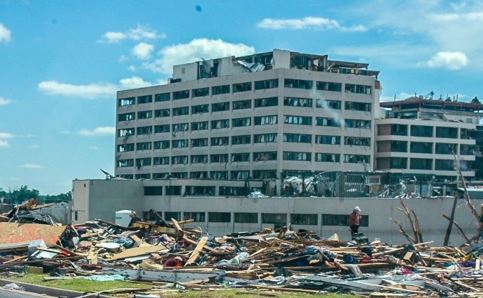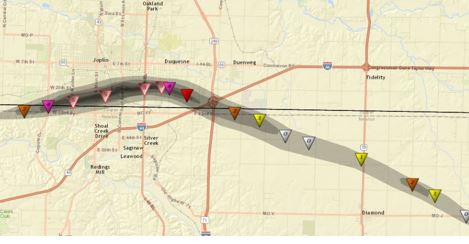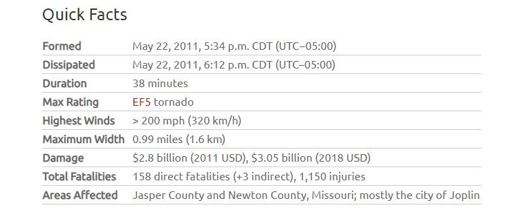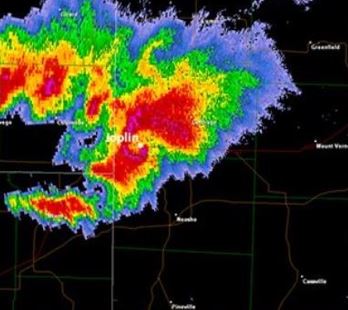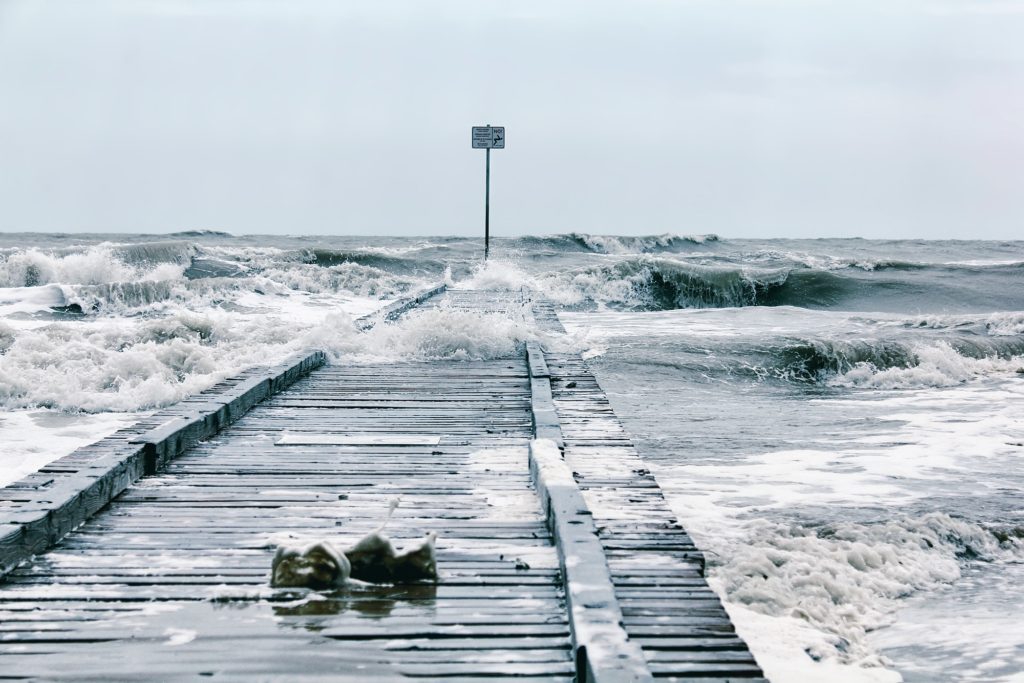On average, May is the month we encounter the most tornadoes in the U.S. There have been many that have been deadly and costly, but one that occurred fourteen years ago stands head and shoulders above the rest. Residents of Joplin, Missouri, and those who witnessed the utter destruction, will never forget its wrath!
Atmospheric conditions were just right for a widespread severe weather outbreak on Sunday, May 22, 2011. That afternoon was a hot and humid one in Joplin, Missouri. As the clock read 5:15 pm. residents were unaware that within two minutes there would be a tornado warning issued and within 20 minutes a large and powerful tornado would plow through their city and in less than an hour there would be unbelievable death and destruction in its wake.
Thirty-Eight Minutes Of Horror
At 5:17 pm. on May 22, 2011, the National Weather Service issued a tornado warning for the Joplin, Missouri, area. There was a severe thunderstorm that was capable of producing a tornado moving toward the city.
At 5:34 p.m. a tornado touched down west of Joplin near the Missouri/Kansas border and was moving eastward. Initially, this was a weak EF-0 tornado. This tornado was unique, however, because it intensified rapidly on its journey toward Joplin. There were observations from storm chasers reporting multiple vortices circulating around the original tornado.
Civil defense sirens blared in Joplin a full 20 minutes before the tornado struck but very few residents responded to the warning. The tornado inflicted damage on the rural areas outside of Joplin as it moved toward the city. Trees and power lines were toppling as the tornado strengthened to an EF1 and then EF2 as it entered the first subdivisions of Joplin.
Several homes were destroyed in the southwest portion of the city. The tornado strengthened to an EF-3 with multiple vortices, as it continued to obliterate more subdivisions. Debris was blowing all around vehicles were lifted into the air and some crashed into homes.
The tornado became a large wedge, nearly a mile wide, as it strengthened to an EF-4 as it entered a more commercial area. Within a minute, it was an unbelievable EF-5 unleashing incredible destruction.
Businesses and medical buildings were gone instantly as concrete walls came smashing down. Steel girders were ripped away and twisted like pretzels. More vehicles were thrown around and some were found wrapped around trees. Concrete parking stops were picked up and thrown some 60 yards away.
The most prominent building was the St, John’s Regional Medical Center which ended up with missing windows, walls, and ceilings. A life flight helicopter on the roof was completely blown away. Five people lost their lives there. The nine-story building was so damaged that it had to be torn down.
A photo showing EF-5 tornado damage to the St. Johns Regional Medical Center in Joplin, Missouri on May 22, 2011. Photo – Public Domain.
Vehicles in the parking lot were tossed around and crashed beyond recognition. One large truck was thrown 125 yards and wrapped around a tree. Every house in the vicinity was totally destroyed and trees were either uprooted or debarked!
The tornado paraded eastward (as an EF5) damaging every building in its path. It barely missed the downtown area to the south, however. There was more extensive damage to homes and parts of concrete driveways were destroyed. Vehicles continue to be tossed around. Some residents never did find their vehicle after the tornado passed by.
An aerial view of subdivision damage inflicted by an EF-5 tornado that struck Joplin, Missouri on May 22, 2011. Photo Credit – Bob Webster/Public Domain.
St. Mary’s Catholic Church, Franklin Technology Center, Joplin High School, and the Greenbriar Nursing Home were all destroyed. Unfortunately, there were 21 fatalities at the nursing home. Fortunately, the high school was unoccupied. A graduation ceremony for the high school had just concluded at Missouri Southern State which was north of where the tornado hit. To the east, a bank was destroyed and a concrete vault was all that remained.
The tornado became rain-wrapped and difficult to see as it moved toward the southeast side of the city. The damage was catastrophic. At a Pizza Hut restaurant, the store manager took four employees and fifteen customers to a walk-in freezer. He couldn’t completely shut the door, however, and as he was holding the door shut he was sucked out and killed as the tornado hit.
Nearby, a Walmart Supercenter was totally destroyed.
This map shows the path and categories of a destructive tornado that struck Joplin, Missouri, on May 22, 2011. Map Credit-NWS.
An industrial park and several subdivisions were destroyed as the tornado departed Joplin and over toward Interstate 44. The tornado then weakened and finally dissipated at 6:12 p.m.
Aftermath And Recovery
I was with The Weather Channel at the time and we had a live crew stationed within 15 minutes of Joplin that afternoon ready to cover severe weather. After the tornado passed through, our live crew, with Meteorologist Mike Bettes as the reporter, made the quick trip to Joplin. What the crew witnessed was described as “surreal” and well beyond what the mind can fathom and it still haunts them to this day.
The destruction, loss of life, and carnage were widespread. When Mike delivered his first report from the scene he was visibly shaken and couldn’t hold the tears back. Mike, along with our great crew, offered assistance in any way possible to the poor souls of Joplin.
Over 150 people lost their lives in the event and overall damage made it the costliest in U.S. history which totaled nearly three billion dollars (around 4 billion in 2024 dollars).
Here are some facts from the Joplin tornado from tornadofacts.net
According to the American Red Cross, about a quarter of the city was destroyed. There was damage to three-quarters of the city with 2000 buildings destroyed.
Nearly 7,000 houses were destroyed and over 800 were damaged. Power and communications were lost but three cell towers were reconstructed within two days.
With the help from more than a dozen Federal agencies, federal and state disaster assistance, as well as the Federal Emergency Management Agency (FEMA), the Department of Housing and Urban Development (HUD), and HUD’s Community
Development Block Grant program along with donations from all over the world led to repairing and rebuilding hundreds of homes and apartments.
By September 2014 all of the destroyed elementary schools, and Joplin High School, had been returned to permanent facilities. The Mercy Hospital Joplin was also rebuilt and opened its doors in March 2015 . In 2017, the Kansas City University of Medicine and Biosciences College of Osteopathic Medicine was also opened.
The Joplin tornado was the first major weather event where social media played a significant role in information and recovery efforts. Facebook groups and websites coordinated information, needs, and offers. The results were so effective the project became a finalist in the 2011 Mashable Awards for Best Social Good Cause Campaign.
Meteorological Conditions
The atmosphere was very conducive that day for a significant severe weather outbreak across the midsection of the nation. Severe weather was widespread from Oklahoma to Michigan and there were 70 tornado reports.
At the surface, there was an area of low pressure over South Dakota and Joplin was experiencing a very warm and humid afternoon with plenty of Gulf moisture moving in. Just to the west was a cold front and there was a potent jet stream aloft in the region so there was plenty of energy.
A surface weather map showing surface and upper-level features on May 22, 2011.
There was also a dry line extending from just west of Joplin down to Texas. The combination of surface features created a good bit of low-level wind shear. There was plenty of warmth and moisture around to fuel the storms !
A base reflectivity radar image of the Joplin, Missouri, tornado on May 22, 2011. Image Credit-NWS.
The sum of these factors led to the development of severe thunderstorms in the Plains and Midwest. The wind shear around the Kansas-Missouri area aided with the development of tornadic cells. One of these developed just to the west of Joplin and it intensified rapidly. The quick and dramatic intensification of this tornado is quite rare and it took many by surprise.
Hopefully, we won’t see more EF5 tornadoes striking cities and towns, but it’s sure to happen someday.

